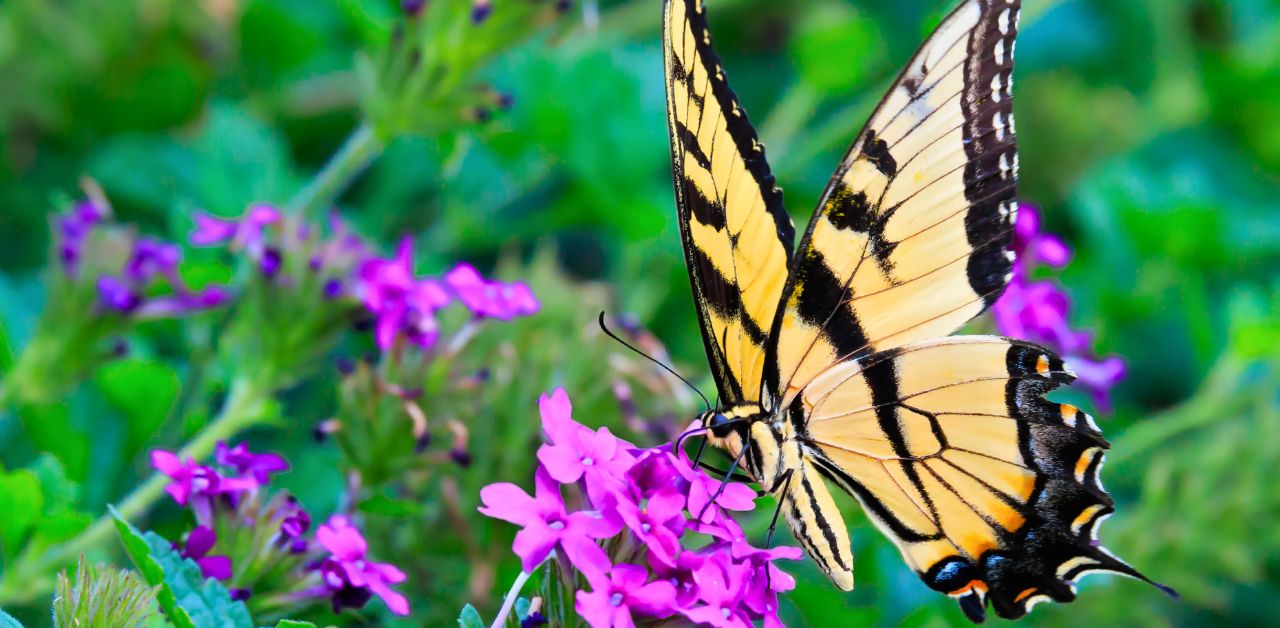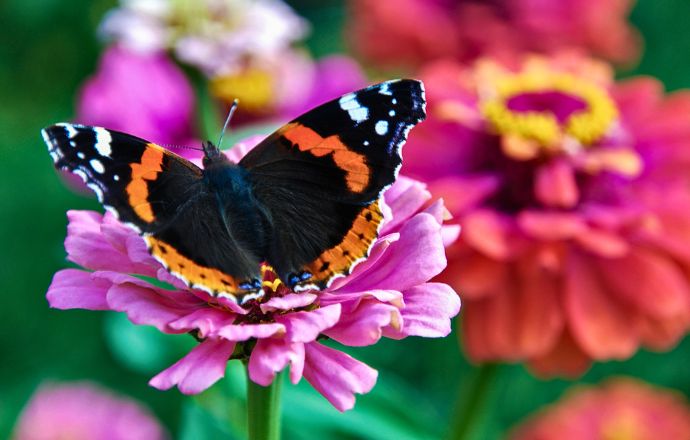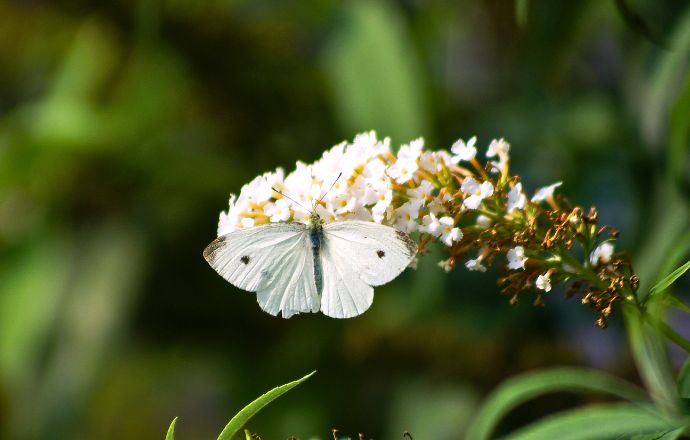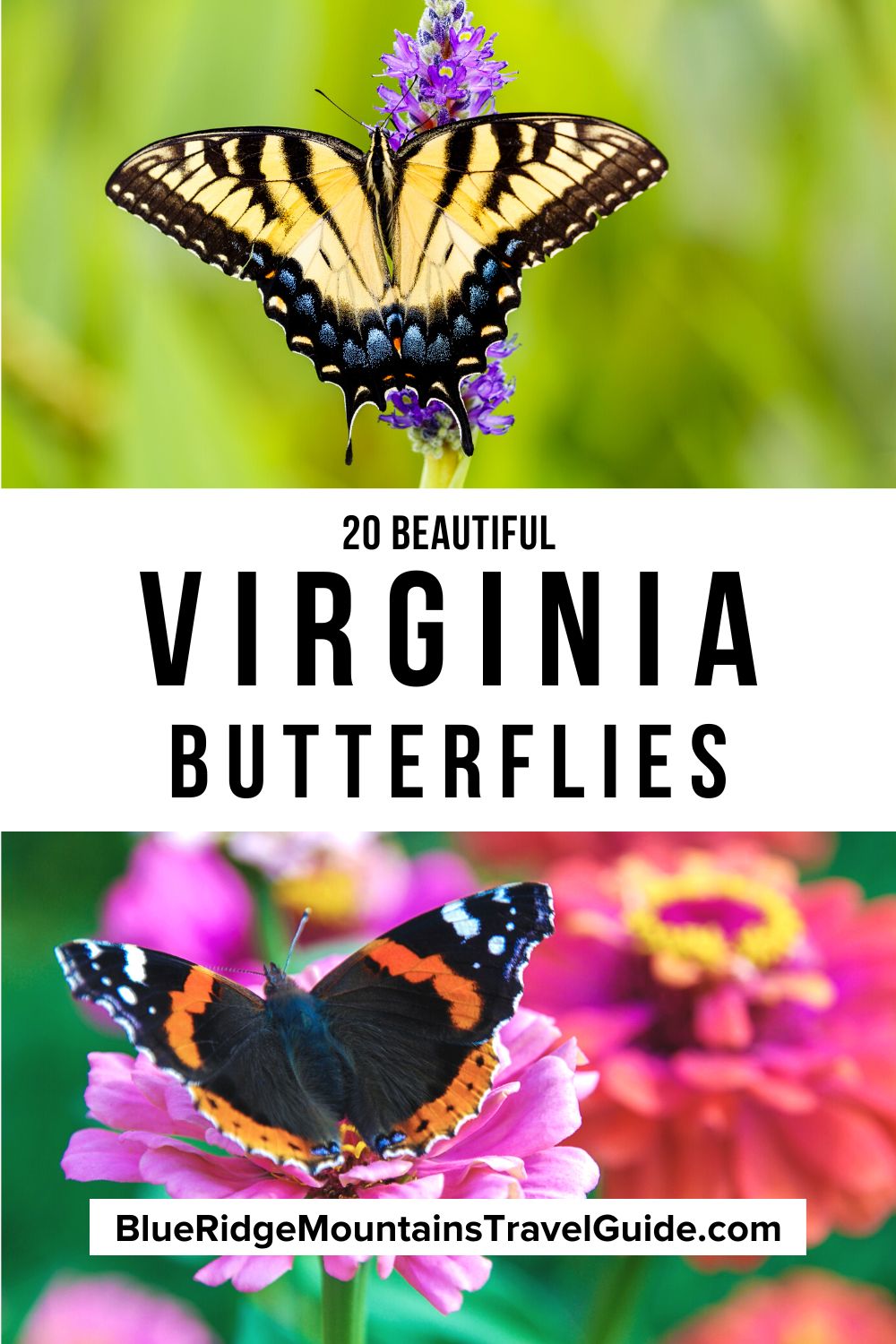My husband and I live in a cabin we built near Doughton Park and Elkin NC, about 20 miles south of the VA border. So we tend to spend a good bit of time in Southwest Virginia (a.k.a. SWVA).
Because we’re professional gardeners, we love spending time in nature, tending to shrubs and flowers that attract pollinators such as birds, bees, and butterflies.
In our experience, the butterflies in VA are numerous, fascinating, and exquisitely beautiful.
Aside from adding color and interest to our home garden, butterflies are extremely important to our ecosystems.
Butterflies, along with birds and bees, are responsible for the pollination of over 75% of the world’s plants.
Sadly, habitat loss and the mass use of pesticides have proven disastrous for many of these essential creatures.
If you enjoy exploring the Blue Ridge Mountains, it’s worth taking some time to learn about a few of the 100+ Virginia butterflies you’re likely to see in the state.
Read on for our introductory guide to the butterflies in Virginia, including details for identifying each species and tips on where you might find them.
READ MORE: The 10 Best National Parks in Virginia
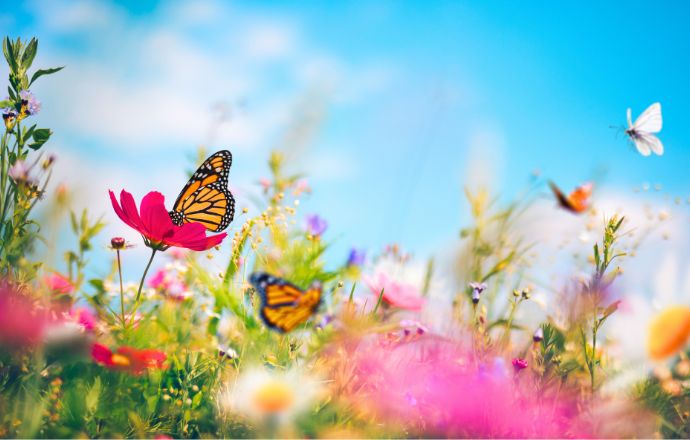
Beautiful Butterflies in VA Guide
- Monarch
- Painted Lady
- Question Mark
- Viceroy
- Spicebush Swallowtail
- Mourning Cloak
- Hackberry Emperor
- Gray Spangled Fritillary
- Orange Sulphur
- Gray Hairstreak
- American Lady
- Red Admiral
- Eastern Tiger Swallowtail
- Common Buckeye
- Pearl Crescent
- Zebra Swallowtail
- Clouded Sulphur
- Cabbage White
- Easter Tailed Blue
- Pipevine Swallowtail
READ MORE: 30 Fun Facts About Virginia State History and Culture

1. Monarch Butterfly
Danaus plexippus
Listed as endangered on the International Union for Conservation of Nature Red List of Threatened Species, Monarch Butterflies are truly a treasure to behold.
This migratory butterfly makes an annual journey of up to 2,800 miles, from southeastern Canada and the northeastern U.S. all the way to the mountains of Mexico. There, they hibernate from November to March.
Among other issues, habitat loss is what puts Monarch Butterflies on the endangered list. They can only lay their eggs on milkweed (Asclepias spp.), and as the commonality of this plant declines, so does the butterfly’s chance to reproduce.
If you have any space to grow a pollinator garden, try to sow some milkweed seeds that are native to your area and help these important insects.
Look out for these butterflies in VA in the fall. We’re lucky to see Monarch Butterflies at home, feeding on our garlic grass flowers every summer.
READ MORE: The 15 Best Virginia Waterfalls for Hiking
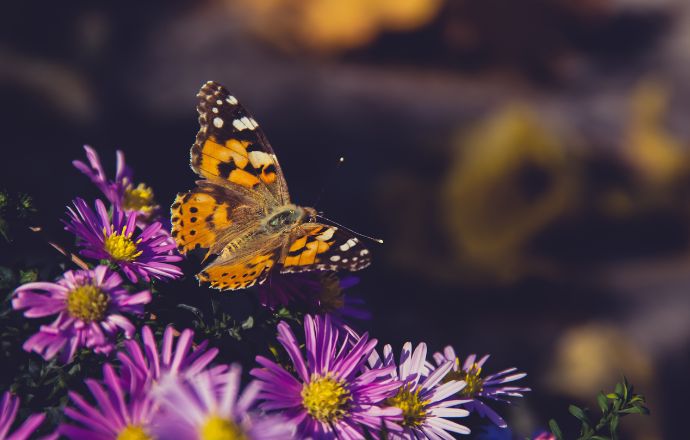
2. Painted Lady Butterfly
Vanessa cardui
You probably recognize the Painted Lady, as it is the most widespread of all the butterfly species. They can be found on every continent except for Australia and Antarctica.
Painted Ladies are about two and a half inches long, with orange, brown, and white markings on their wings.
These beautiful butterflies thankfully have a choice of more than 100 species of plants to lay their eggs on. But their favorites are thistles, hollyhock, plants of the mallow family, and various legumes.
Adults have a smorgasbord of favorite wildflower delicacies, from red clover and ironweed to cosmos and joe-pye weed.
Keep an eye out for Painted Lady Butterflies in Virginia throughout summer and into fall.
READ MORE: The 10 Best Things to Do in Bristol TN/VA

3. Question Mark Butterfly
Polygonia interrogationis
Named after little punctuation marks that appear on the underside of its wings, the Question Mark Butterfly is one of the common butterfly species found throughout the eastern parts of the USA and Canada.
Its scientific name, Polygonia, refers to the “many angles” that can be seen along the outlines of its wings. When its wings are closed, these butterflies could easily be mistaken for dead leaves.
They can be found along the edges of forest areas and city parks in Virginia.
Question Mark Butterflies will feed from wildflowers such as milkweed and asters, but only if their favorite foods– rotting fruit, dung, and carrion– are not readily available.
You will likely see these colorful Virginia butterflies from June through September.
READ MORE: The 10 Best Civil War Battlefields in Virginia to Visit
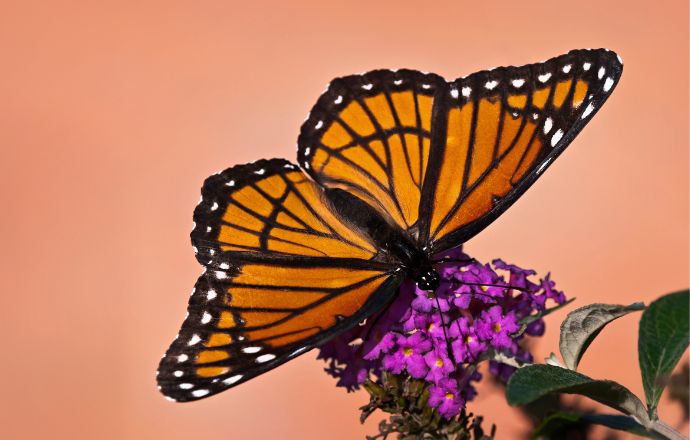
4. Viceroy Butterfly
Limenitis archippus
Here we have another beautiful butterfly that, early in the season, prefers to feed on less-than-pretty piles of dung, rotting fungi, and carrion.
Later in the year, Viceroy Butterflies will feast on wildflowers such as aster, goldenrod, and joe-pye weed.
They’re known as the “Viceroy” due to their remarkable similarities to the larger Monarch Butterfly. The easiest way to tell the difference between them is to look for a black horizontal line across the hindwings of the Viceroy.
These brilliant VA butterflies do not migrate at all. Be on the lookout from late spring through mid-fall.
READ MORE: The 10 Best Historic & Covered Bridges in Virginia
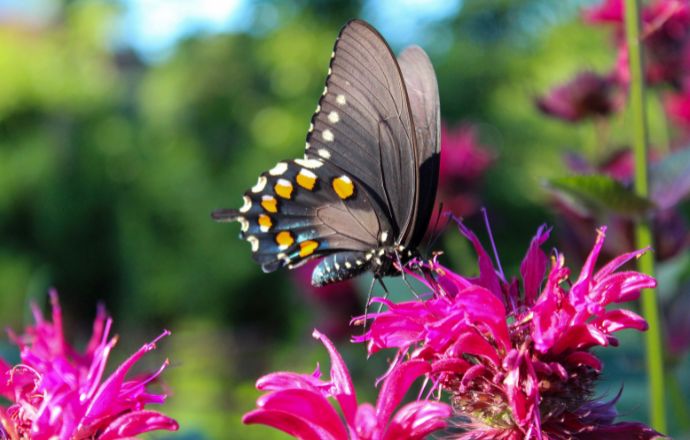
5. Spicebush Swallowtail Butterfly
Papilio troilus
The Spicebush Swallowtail Butterfly is fairly common along the East Coast, and they can often be seen in forests, parks, roads, and yards.
These insects are very common butterflies in Virginia during the warmer months.
Adult Spicebush Swallowtails are mostly black, with a bluish band on the upper side of their hindwings. To tell them apart from other black Swallowtails, look for the orange spots on the upper side of the wings.
Their caterpillars are pretty remarkable, too, with false eyes and an enlarged thorax that give them the look of a green snake, which is perfect for protection against predators!
Spicebush Swallowtail larvae eat spicebush, sassafras, and sweet bay, while the adults prefer to feed on honeysuckle, clover, beebalm, and milkweed.
READ MORE: The 10 Best Caves and Caverns in Virginia
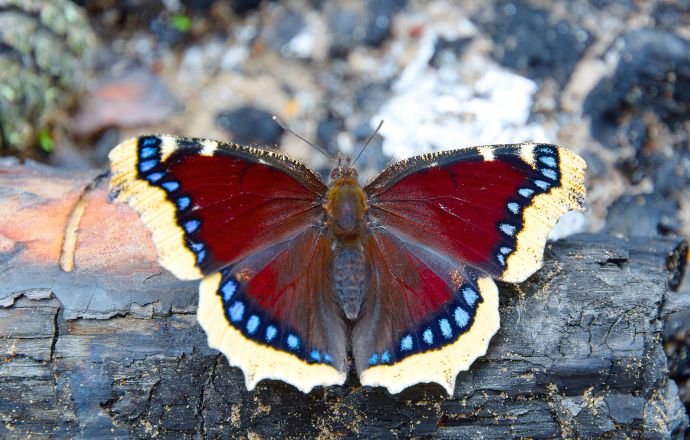
6. Mourning Cloak Butterfly
Nymphalis antiopa
The distinctive Mourning Cloak Butterfly has dark maroon wings with a yellow border lined with blue spots along their jagged margins.
This particular butterfly belongs to the Nymphalidae, or brush-footed, family. They’re called brush-footed because it appears that they only have four legs, as opposed to the requisite six that all insects have.
Instead, their two forelegs have evolved to be short, stumpy, and almost completely hidden in many cases.
Host plants for Mourning Cloak Butterfly eggs include various willow trees, as well as American elm, aspen, and paper birch. Adult butterflies prefer the sap of oak trees, and will sometimes feed on rotting fruit.
READ MORE: Apple Picking in Virginia: The 15 Best VA Apple Orchards to Visit
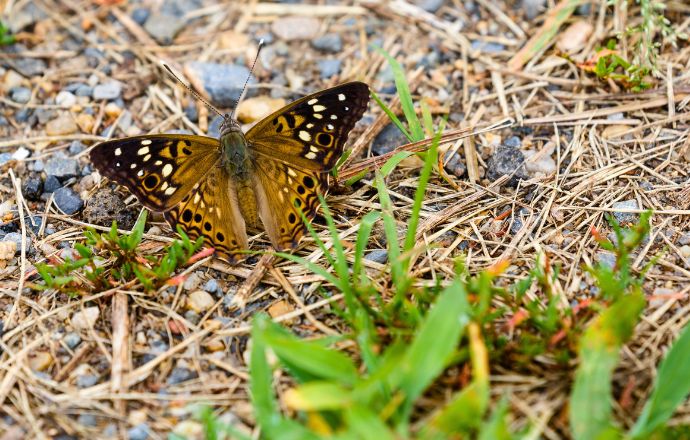
7. Hackberry Emperor Butterfly
Asterocampa celtis
The small, reddish-brown Hackberry Emperor Butterfly is very common in Virginia.
It has white spots near the tips of its forewings, while the underside of the hindwing has eye spots with bright blue centers.
These Virginia butterflies lay their eggs in clusters on the underside of hackberry tree leaves, and feed on fermenting fruit, dung, and carrion.
Look out for them in damp wooded areas, yards, and parks.
READ MORE: The 10 Best Virginia State Parks to Visit
8. Gray Spangled Fritillary Butterfly
Speyeria cybele
The range of these American butterflies reaches across almost the entire USA, from just north of Georgia up into Canada.
They prefer moist climates, and can often be found in woodlands and prairies.
Gray Spangled Fritillary Butterflies are quite large, with scalloped fore- and hindwings. Both males and females are orange/brown, but females are more pale, with a blackish color towards the rear half of their wings.
Both sexes are pale orange towards the edge of their wings, with pale orange undersides and black spots on the upper side of the forewings.
Their caterpillars enjoy eating the leaves of various violet species, while adult butterflies prefer to sip the nectar of wildflowers such as ironweed, bergamot, joe-pye weed, and mountain laurel.
READ MORE: The 10 Best Campgrounds in Virginia

9. Orange Sulphur Butterfly
Colias eurytheme
Orange Sulphur Butterflies are primarily a vivid orange, though females may appear closer to white.
Both males and females have a dark-colored border on their wing, with a dark spot on their forewings and a lighter spot on their hindwings.
These VA butterflies will lay their eggs on plants from the legume family, including alfalfa and clover. Adult butterflies can feed from a variety of common wildflowers in Virginia, from dandelions to asters.
Orange Sulphur Butterflies can typically be seen alfalfa fields, meadows, and pretty much anywhere that clover is growing.
READ MORE: The 10 Best Virginia Mountain Towns to Visit

10. Gray Hairstreak Butterfly
Strymon melinus
Tiny Gray Hairstreak Butterflies have a wingspan of just 1 to 1.25 inches wide.
Both males and females have gray to blue-gray on the upper surfaces of their wings, with an orange spot at the base of each hindwing.
Their undersides are lighter gray, with white and black lines and orange and blue spots along the margins of their hind wings.
Gray Hairstreak Butterflies can often be spotted in open areas, such as vacant lots and other weedy spaces.
The caterpillars feed on different types of clover, and other plants of the legume and mallow family.
READ MORE: 10 Great Romantic Getaways in Virginia for Couples
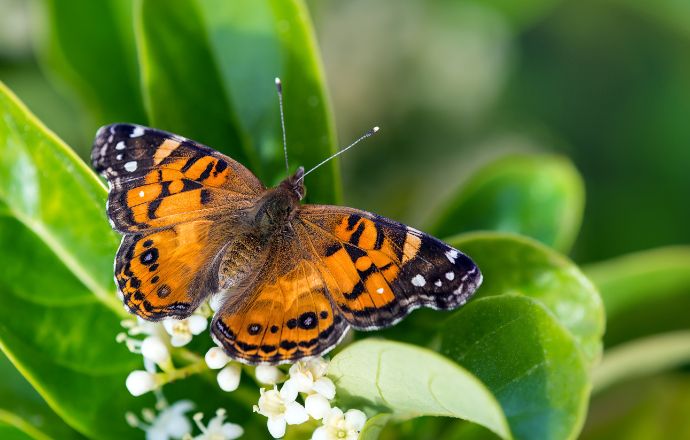
11. American Lady Butterfly
Vanessa virginiensis
American Lady Butterflies are easily identified by the two large eye spots on the underside of each of their hindwings.
The upper side of their wings are brown, yellow, and orange, with small white spots near the tips of their forewings.
12. Red Admiral Butterfly
Vanessa atalanta
Red Admiral Butterflies are very distinctive, with black wings showing off red stripes and white spots.
This migratory species is one of the most widespread Virginia butterflies.
Adults can often be spotted feasting on fermented fruits, tree sap, and bird poop. They also enjoy the nectar of milkweed, aster, and alfalfa.
Their caterpillars typically eat from plants in the nettle and hop family.
Red Admirals are said to be people-friendly butterflies, so don’t be surprised if they land on you as a perch. You’re most likely to see these butterflies from spring through fall.
READ MORE: 20 Things to Do in the Blue Ridge Mountains of Virginia
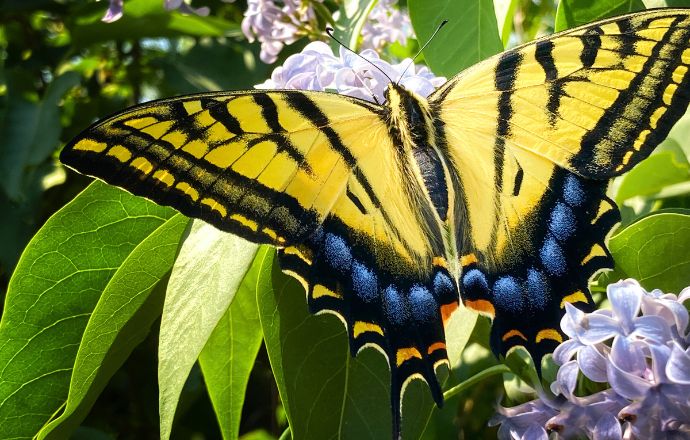
13. Eastern Tiger Swallowtail Butterfly
Papilio glaucus
The official state butterfly of Virginia, the striking Eastern Tiger Swallowtail Butterfly is also one of the most common butterflies in the eastern USA.
It’s a fairly large butterfly, with a wingspan of up to 5.5 inches. Males are yellow, with four black stripes on each forewing, while females may be black or yellow.
If they’re yellow, they’ll have a strip of blue spots along their hindwing. But if they’re black, they’re almost entirely black, with light blue specks at the base of their hindwings.
A group of butterflies is called a kaleidoscope, though they may also be called a swarm, rabble, or rainbow.
Eastern Tiger Swallowtails tend to be solitary butterflies, though you might come across a kaleidoscope of males on the ground drinking from a puddle.
This lovely species of butterfly feasts on flower nectar, with phlox, ironweed, and lilac ranking among its favorites.
READ MORE: The 10 Best Virginia Wineries to Visit for Wine Tastings & Tours
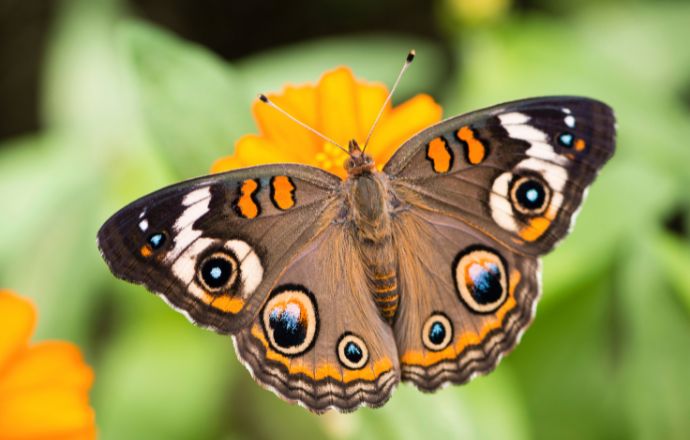
14. Common Buckeye Butterfly
Junonia coenia
Common Buckeye Butterflies are really distinctive due to their striking eye spots, which have brightly colored middles.
These butterflies are otherwise orange and brown, with dark stripes along the margins of their scalloped wings.
They lay solitary eggs on plants such as snapdragons and plantains, leaving the caterpillars solo in their feeding quest.
Adult butterflies enjoy eating aster, chicory, and even peppermint plants.
You can find them in open spaces such as meadows, pastures, and along scenic roads in Virginia.
READ MORE: The 10 Best Things to Do in Staunton VA
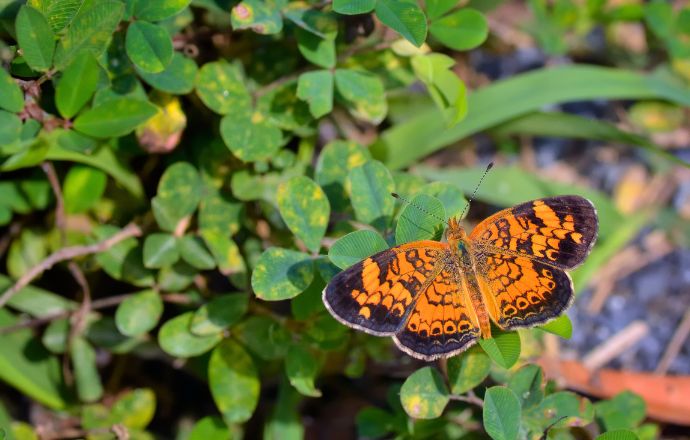
15. Pearl Crescent Butterfly
Phyciodes tharos
Pearl Crescents are another tiny little species of VA butterflies, measuring just 1.75 inches wide.
They’re bright orange in color, with black borders on their wings and various spots and lines.
They can often be found in open, sunny, and moist areas.
Their favorite places include woodland edges, fields, meadows, gardens, and anywhere where you find aster plants.
The females lay clusters of eggs on the upper surface of aster plants, allowing the caterpillars to devour leaves in hoards. Adult butterflies enjoy the nectar of asters, as well as dogbane and milkweed.
READ MORE: The Best Ski Resorts in the Virginia Mountains to Visit
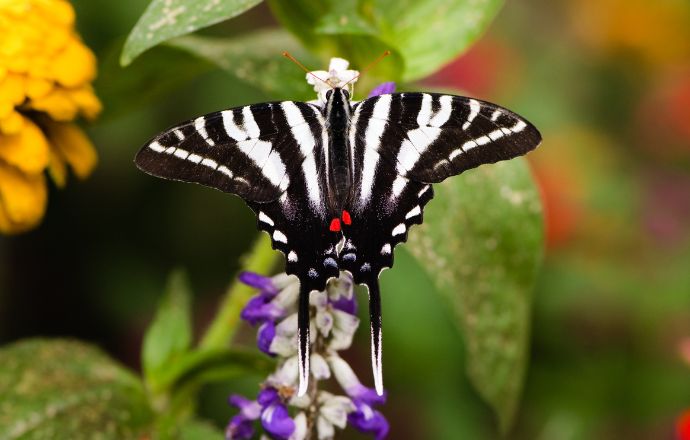
16. Zebra Swallowtail Butterfly
Eurytides marcellus
It isn’t difficult to see how the striking Zebra Swallowtail Butterflies got their name. But their appearance actually differs in the spring and summer.
In the springtime, these butterflies are smaller and greenish-white, with black stripes.
Come summertime, they’ve grown in size and are more of a blue/green color with black stripes.
All through the year, they have a blue spot at the base of each hindwing and a red spot closer to their bodies.
Female Zebra Swallowtails lay individual eggs on the underside of pawpaw leaves, and can be found wherever pawpaw trees are growing. Adults typically feed on the nectar of various flowers.
READ MORE: The 5 Best Places for Snow Tubing in Virginia
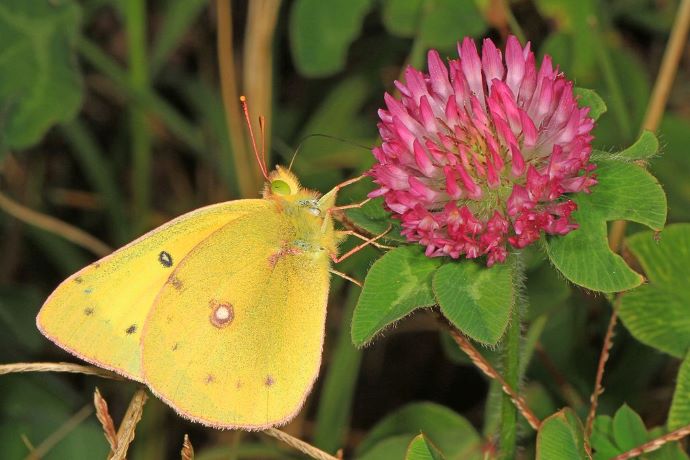
17. Clouded Sulphur Butterfly
Colias philodice
The Clouded Sulphur is one of the most common butterflies of Virginia. It’s small compared to some on this list, with a wingspan of less than 3 inches.
This VA butterfly comes in two colors, light green/white and yellow.
But both have black borders on their wings, and a black spot in the center of their forewings. The underside of the hindwing has a red-rimmed silver spot in the center.
They tend to frequent parks, roadsides, and gardens. They’re often seen hanging out with their cousins, the Orange Sulphur.
Clouded Sulphur Butterflies eat the nectar of various flowers, such as joe-pye weed and goldenrod. They lay their eggs on alfalfa, clover, and plants of the vetch family.
READ MORE: 10 Great Places to Celebrate Christmas in Virginia
18. Cabbage White Butterfly
Pieris rapae
These common butterflies are often seen floating like ghosts through vegetable gardens and other open spaces.
If you’re an avid gardener (as we are), they aren’t butterflies you want to see fluttering over your cabbages and kale.
Their caterpillars will devour brassicas (including broccoli, Brussels sprouts, cauliflower, and collards) in a heartbeat. My husband and I have had to learn to share our harvest.
Cabbage White Butterflies have a wingspan of just 2 inches. They’re pale green to white, with black wingtips and one black spot at the center of each forewing for males and two for females.
Keep an eye out for these little butterflies in VA throughout the summer, when they’ll be eyeing your veggie patch!
READ MORE: The 10 Most Festive Christmas Towns in Virginia to Visit
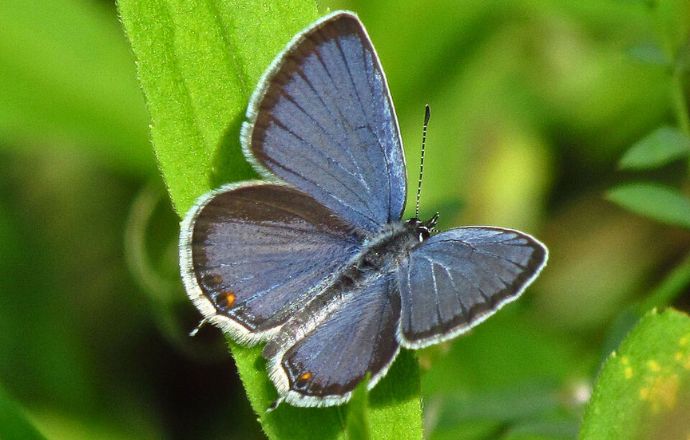
19. Eastern Tailed-Blue Butterfly
Cupido comyntas
Measuring just one inch wide, the tiny Eastern Tailed-Blue Butterfly one of the most commonly seen blue butterflies in VA.
Males have bright blue forewings with brown and white borders, while females have grey/white edges on their wings.
Both sexes have an orange spot at the base of the hindwings. They’re also supposed to have delicate tails at the base of their hindwings, but these are often missing due to their fragility.
Eastern Tailed-Blue butterflies can commonly be found in pastures, gardens, forest trails, roadsides, and vacant lots.
The caterpillars of these butterflies eat the flowers and seeds of leguminous plants, such as clover and vetch.
READ MORE: The 15 Best Lakes in the Virginia Mountains to Visit

20. Pipevine Swallowtail
Battus philenor
These metallic blue butterflies are extremely striking.
Pipevine Swallowtail Butterflies have dark forewings, but their hindwings have an iridescent blue coloring. The underside of their wings has bright orange spots rimmed in black.
Female Pipevine Swallowtails lay clusters of eggs on pipevine (a.k.a. Dutchman’s pipe) plants. Their caterpillars then feed on this toxic plant, which makes them toxic to predators.
Adults feed on the nectar of an array of flowers, such as thistles, lupines, petunias, azaleas, and phlox.
They can often be seen flying in places where pipevines grow in abundance, usually in grasslands, meadows, gardens, and woodlands. -by Emma Gallagher; lead image via Canva

